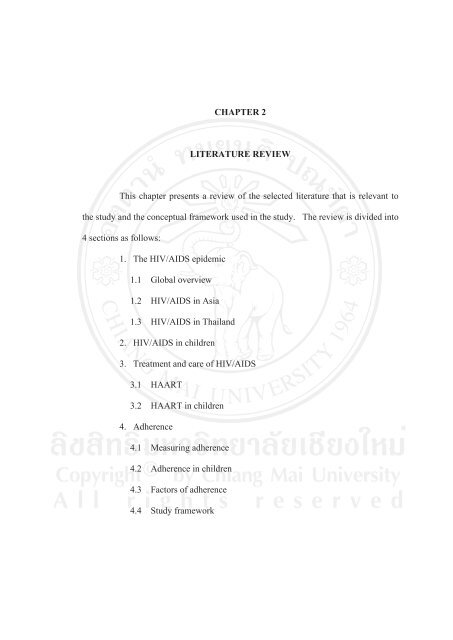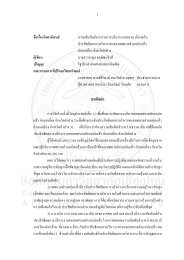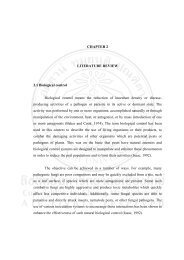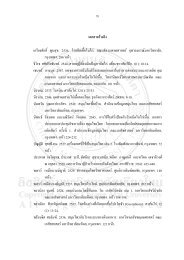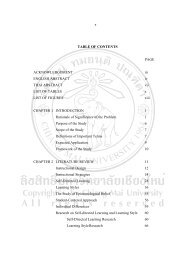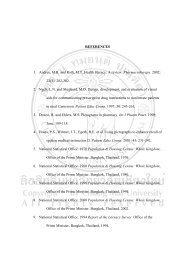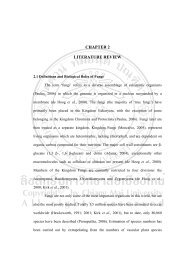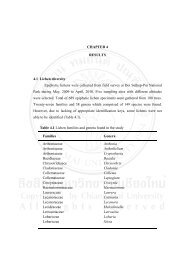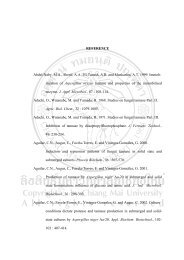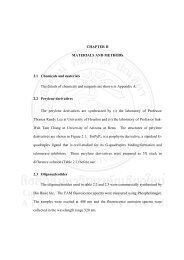CHAPTER 2 LITERATURE REVIEW This chapter presents a review ...
CHAPTER 2 LITERATURE REVIEW This chapter presents a review ...
CHAPTER 2 LITERATURE REVIEW This chapter presents a review ...
Create successful ePaper yourself
Turn your PDF publications into a flip-book with our unique Google optimized e-Paper software.
<strong>CHAPTER</strong> 2<br />
<strong>LITERATURE</strong> <strong>REVIEW</strong><br />
<strong>This</strong> <strong>chapter</strong> <strong>presents</strong> a <strong>review</strong> of the selected literature that is relevant to<br />
the study and the conceptual framework used in the study. The <strong>review</strong> is divided into<br />
4 sections as follows:<br />
1. The HIV/AIDS epidemic<br />
1.1 Global overview<br />
1.2 HIV/AIDS in Asia<br />
1.3 HIV/AIDS in Thailand<br />
2. HIV/AIDS in children<br />
3. Treatment and care of HIV/AIDS<br />
3.1 HAART<br />
3.2 HAART in children<br />
4. Adherence<br />
4.1 Measuring adherence<br />
4.2 Adherence in children<br />
4.3 Factors of adherence<br />
4.4 Study framework
Global overview<br />
13<br />
The HIV/AIDS epidemic<br />
HIV/AIDS is one of the world’s greatest human health crises and in the last<br />
few years, the number of people living with HIV increased in every region in the<br />
world (WHO SEARO, 2007). Since the first reports of AIDS in the US in 1981, HIV<br />
infection has reached pandemic proportions (WHO SEARO, 2007). Over the past 20<br />
years, more than 65 million people have become infected with HIV/AIDS and more<br />
than 25 million have died (UNAIDS, 2007). Every day, over 6,800 people become<br />
infected with HIV and over 5,700 die from AIDS, mostly because of inadequate<br />
access to HIV prevention and treatment services (UNAIDS, 2007). The global HIV<br />
epidemic has emerged as a daunting challenge to public health, development and<br />
human rights, moreover in countries most severely affected, it has eroded<br />
improvements in life expectancy (WHO SEARO, 2007). By 2010 it is estimated that<br />
approximately 100 million people will have been infected and that there will be 25<br />
million AIDS orphans worldwide. Even though there have been huge investments in<br />
research, currently there is still no vaccine for HIV (Medical Research Council<br />
[MRC], 2002). HIV/AIDS still pose grave problems in most countries even though<br />
the estimated number of people living with HIV/AIDS has decreased from 39.5<br />
million [34.1-47.1 million] in 2006 to 33.2 million [30.6-36.1 million], in 2007<br />
(UNAIDS, 2007).<br />
The 2007 UNAIDS report reveals substantial changes in the global estimate<br />
of people living with HIV with a decrease in global HIV estimates, however the<br />
reduction itself is not actually due to a decrease in the number of people living with<br />
HIV but partly because of refinements in the way in which UNAIDS collects and
14<br />
reports its data. Notably, 70% of the reduction in the global estimate can be attributed<br />
to revised estimates for six countries: India, Angola, Kenya, Mozambique, Nigeria,<br />
and Zimbabwe. The single greatest change in HIV estimates is in India where the<br />
2006 estimate of 5.7 million people living with HIV has been amended to<br />
approximately 2.5 million. However the report still highlights the fact that HIV<br />
continues to be a problem of epic proportion with 2.5 million new HIV infections and<br />
2.1 million AIDS-related deaths in 2007; in 2007 over 6,800 people were infected<br />
with HIV everyday and 5,700 die from AIDS, mainly due to insufficient access and<br />
availability of treatment and prevention services (UNAIDS, 2007). Sub-Saharan<br />
Africa is the region with the most affected; home to 22.5 million adults and children<br />
infected with HIV, 68% of adults and 90% of children living with HIV in the world<br />
live in sub-Saharan Africa. The epicentre of the HIV epidemic is southern Africa<br />
accounting for one-third of people living with HIV globally (WHO SEARO, 2007).<br />
HIV/AIDS in Asia<br />
Asia is faced with a multifaceted HIV/AIDS epidemic. Although HIV did<br />
not hit Asian countries until the late 1980s, by the late 1990s the epidemic was well<br />
established across the region (Brown, 2002). Since HIV first appeared over 20 years<br />
ago, approximately 9 million Asians have been infected with HIV; 2.6 million men,<br />
more than 950,000 women, and almost 330,000 children have died of AIDS-related<br />
diseases (Report of the Commission on AIDS in Asia, 2008). UNAIDS reports that in<br />
2007, approximately 446,000 Asians/Pacific Islanders were newly infected with HIV,<br />
bringing the total number living with HIV/AIDS in Asia and the Pacific to 4.9 million,
15<br />
moreover more than 300,000 people died from AIDS-related illnesses in this region in<br />
the same year.<br />
Despite the progress made in many of the countries in Asia and the<br />
declining trend of new HIV infections in a few of them, AIDS currently accounts for<br />
more deaths annually among 15–44 year-old adults than do tuberculosis and other<br />
diseases (Report of the Commission on AIDS in Asia, 2008). The prevalence of HIV<br />
in some South-East Asian countries remains relatively low, however with a<br />
population that is approximately 60% of the world’s total, even low prevalence can<br />
mean a large proportion who are infected (WHO SEARO, 2007). The World Health<br />
Organization, South-East Asia office (2007) reports that the prevalence of HIV varies<br />
widely between and within Asian countries, India with the highest number of HIV<br />
infections (5.2 million) to the Maldives with less than 100. Furthermore, they<br />
highlighted the point that vulnerable segments of the population have<br />
disproportionately high HIV infection rates. Male and female sex workers and<br />
injection drug users were the first groups to be seriously affected by HIV/AIDS in<br />
most of Asia and the Pacific and remain critical engines of the epidemic (WHO<br />
SEARO, 2007).<br />
South-East Asia, with an estimated 7.2 million people living with HIV has<br />
the second highest burden of HIV in the world, following sub-Sahara Africa (WHO<br />
SEARO, 2007). According to the WHO South-East Asia Region report, 2007 the<br />
majority of the HIV burden in the region is in India, Indonesia, Myanmar, Nepal and<br />
Thailand (adult prevalence; 0.9%, 0.2%, 1.3%, 0.5%, 1.4% respectively). The source<br />
of South-East Asia’s HIV/AIDS epidemic is found in the social problems faced by the<br />
people. There has been an increase in population mobility and environmental
16<br />
deprivation because of the economic turmoil the region has faced over the past two<br />
decades (WHO SEARO, 2007). Sexual transmission of HIV is exacerbated by this<br />
mobility, with migrant workers spending long periods of time away from home and<br />
frequently visiting sex workers, then returning home to infect their spouses, who in<br />
turn pass the virus to their newborns (UNFPA, 2002). Although the epidemics vary<br />
considerably from country to country, they share important characteristics, namely<br />
that they are centred mainly around: unprotected paid sex, the sharing of<br />
contaminated needles and syringes by injecting drug users, and unprotected sex<br />
between men (Report of the Commission on AIDS in Asia, 2008).<br />
HIV/AIDS in Thailand<br />
Thailand identified its first case of HIV in 1984, HIV then began to spread<br />
among intravenous-drug users (IDU’s), from there to commercial sex workers<br />
(CSW’s) and their clients, and then from the male clients to their wives and<br />
girlfriends (Brown & Sittitri, 1995). Thailand is among the few countries in the<br />
world to have turned around a rapidly escalating generalized HIV epidemic; the<br />
number of estimated new infections decreased from 140,000 (per year) in 1991 to<br />
17,000 in 2005 (WHO SEARO, 2007). The overall HIV/AIDS epidemic in Thailand<br />
can be divided into five major epidemic waves, among homosexual males (1984-5),<br />
among intravenous drug users (1988), among female commercial sex workers (1989),<br />
among male clients of commercial sex workers (1990), and among family housewives<br />
and newborns (1991) (Berkely, 1993).<br />
The ensuing response from all sections of the government and society<br />
helped to slow transmission, Thailand’s comprehensive prevention programs,
17<br />
including the female sex workers targeted “100% Condom Programme” implemented<br />
in 1991, have substantially reduced the levels of sexual risk behaviour in Thailand and<br />
cut the annual new HIV infections to about 30,000, from a high of 140,000 a decade<br />
ago (MOPH/WHO SEARO, 2005). Thailand is one of the few countries to have<br />
achieved its Millennium Development Goal of reversing the spread of HIV by 2015<br />
(UNDP, 2007). However by the end of 2007 an estimated half a million Thais were<br />
living with HIV/AIDS, with four in ten new infections occurring among women,<br />
many infected by their husbands and prevalence among injection drug users remains<br />
high, ranging between 30% and 50% (World Health Organization, 2007).<br />
The situation of HIV is particularly serious in Northern Thailand; six<br />
provinces in Thailand’s Upper North region suffer the largest burden of the HIV<br />
epidemic accounting for around 40% of the country’s AIDS cases, they include;<br />
Chiang Mai, Lamphun, Lampang, Mae Hong Song, Chiang Rai and Phayao (UNDP,<br />
2007). One of the crucial factors in dispersal of the infection was the active and<br />
multifaceted population movement (Herdt, 1997). Herdt identified another key factor<br />
in the spread of the HIV epidemic, the internal and international migration of sex<br />
workers (Herdt, 1997). Since prostitution was an acceptable career in the north, these<br />
women represented the largest category of female commercial sex workers in<br />
Thailand (Bond, Celentano, Phonsophakul, & Vaddhanaphuti, 1997).<br />
Wongkhomthong and colleagues (1995) highlighted that the cycle and spread of HIV<br />
began when these commercial sex workers migrated from their home in the north,<br />
they continued to work until some contracted HIV when they returned home. New<br />
workers from the same area were recruited and the cycle began again, as a result HIV<br />
prevalence continues to remain in the north (Wongkhomthong, Kaime-Atterhog, &
18<br />
Ono, 1995). By 1989, HIV prevalence as high as 43% had been found in one survey<br />
of brothel-based sex workers in Chiang Mai (UNDP, 2004).<br />
According to the UNAIDS/WHO Epidemiological Fact Sheet-2004 Update,<br />
as of January 2004, 231,712 AIDS cases were reported, of whom nearly 80% were in<br />
the 20-39 year age group (reproductive years), moreover the report predicts that there<br />
will be 50,000 new AIDS cases in Thailand every year.<br />
Even though Thailand can boast relative success in reducing new HIV<br />
infection, the number of children with at least one parent who lives with HIV has<br />
gradually increased (UNDP, 2007). Studies suggest that approximately 3,000 Thai<br />
children contract HIV each year. One-seventh of new infections occur in children.<br />
The Ministry of Public Health and UNAIDS (2005) released figures that showed the<br />
number of children in Thailand living with HIV to be estimated at 23,000. In Chiang<br />
Mai city, there are approximately 1,122 children under 14 infected with HIV (Chiang<br />
Mai Provincial Public Health Office, 2007).<br />
HIV/AIDS in children<br />
All people infected with HIV experience, to a greater or lesser degree,<br />
physical, psychological, and socioeconomic suffering as a result of the disease. For<br />
children this can seem magnified (UNICEF, 2005). Each day, some 1,500-2,000<br />
children under 15 years become infected with HIV (WHO, 2006). In 2007, around<br />
half a million children under 15 were infected with HIV/AIDS and 400,000 died<br />
(UNAIDS, 2007). Moreover, roughly 14 million children have lost one or both<br />
parents due to AIDS (UNAIDS/UNICEF, 2005).
19<br />
According to the WHO factsheets on HIV/AIDS for nurses and midwives<br />
(WHO SEARO, 2002), almost all HIV-infected children acquire the virus from their<br />
mothers before or during birth or through breastfeeding, however some children as<br />
well as adults have been infected through transfusions with blood or blood products<br />
contaminated with HIV. A small number of children also have been infected through<br />
sexual or physical abuse by HIV-infected adults (UNAIDS, 2002). Most mother to<br />
child transmissions (MTCT), estimated to cause more than 90% of infections<br />
worldwide in infants and children, probably occur late in pregnancy or during birth.<br />
The risk of MTCT is significantly increased if the mother has advanced HIV disease,<br />
increased levels of HIV in her bloodstream, or fewer numbers of CD4+ T cells (WHO<br />
SEARO, 2002). One in six people dying of HIV-related illness worldwide is a child<br />
under 15 years and this is due largely to the failure to introduce programmes for<br />
preventing MTCT of HIV on the scale needed (WHO, 2006).<br />
Without appropriate HIV care, including ART, the progression of HIV<br />
infection in children is particularly aggressive (WHO, 2006). Children infected with<br />
HIV have increased frequency of common childhood illnesses and they tend to be<br />
more persistent and severe, without correct treatment, care and support, HIV<br />
multiplies and destroys the defences leaving the child less able to resist pneumonia<br />
and other opportunistic infections (UNICEF, 2005). In addition, infected infants often<br />
do not respond well to treatment and they commonly suffer fatal complications (The<br />
National Institute of Allergy and Infectious Diseases [NIAID], factsheet, June 2004).<br />
Children living with HIV have higher nutritional requirements and malnutrition can<br />
weaken the immune system and allow HIV infection to progress more quickly<br />
(UNICEF, 2005).
20<br />
Furthermore, the mother and child with HIV usually are not the only family<br />
members with the disease. More often than not, the mother's sexual partner is<br />
infected, and other children in the family may be infected as well. Frequently, a<br />
parent with AIDS does not survive to care for his or her HIV-infected child (The<br />
National Institute of Allergy and Infectious Diseases [NIAID], factsheet, June 2004).<br />
Levine, Foster, & Williamson in an excerpt their book ‘A Generation at Risk: The<br />
Global Impact of HIV/AIDS on Orphans and Vulnerable Children’ point out that<br />
HIV/AIDS impacts children, families, and households in numerous ways. The impact<br />
usually starts with an HIV infected parent, the child’s life is then limited due to the<br />
deterioration in the parent’s health which then ultimately leads to death. The child’s<br />
life is severely limited by financial burdens; they often have to take over as the<br />
breadwinner, caregiver of additional parent, they lose or have limited educational<br />
opportunities, and suffer psychosocial distress and many more difficulties that can<br />
ultimately lead worsening outcomes.<br />
According to UNAIDS, the most effective way to reduce the number of<br />
children who become infected with HIV is to prevent HIV infection in parents-to-be<br />
and to prevent unplanned pregnancies in HIV infected women (UNAIDS, 2002).<br />
Treatment and care of HIV/AIDS<br />
Every day, over 6,800 people become infected with HIV and over 5,700 die<br />
from AIDS, mostly because of inadequate access to HIV prevention and treatment<br />
services (UNAIDS, 2007). The only way HIV infection can be managed is through a<br />
combination of antiretroviral drugs and these have proven to be efficient in restoring<br />
strength to inflicted persons, even those who were close to death (Kelly, 2006). Once
21<br />
started, antiretroviral treatment must continue for the rest of an individual’s life<br />
(WHO SEARO, 2004). In addition, the virus can develop resistance to the drugs<br />
therefore observation of the individual must be conducted on a regular basis to<br />
guarantee that resistance has not developed or, if it has, to change or adapt<br />
medications (Kelly, 2006).<br />
HAART (Highly Active Antiretroviral Therapy)<br />
Over the last five or so years there have been dramatic changes in treatment<br />
approaches, treatment has moved from mono-therapy and by-therapy to triple drug<br />
therapy (Horizons Population Council, 2004). Highly Active Antiretroviral Therapy<br />
(HAART) is the treatment regimens recommended by HIV experts to aggressively<br />
decrease viral duplication and progress of HIV disease (WHO, 2006). The usual<br />
HAART treatment combines three or more different drugs and these treatment<br />
regimens have been shown to reduce the amount of virus so that it becomes<br />
undetectable in a patient's blood. There is no doubt that HAART is one of the most<br />
celebrated treatment advances in recent medical history (WHO, 2003). It has led to<br />
significant reductions in morbidity and mortality as well as enhancing disease-related<br />
quality of life for many infected persons (Bartlett, Demasi, Quinn, Moxham, &<br />
Rousseau, 2001).<br />
The goal of HAART is to attain maximum and enduring suppression of<br />
virus replication, which in turn reduces the destruction of CD4 cells and consequently<br />
slows disease progression (Horizons Population Council, 2004). Because of HAART,<br />
many people with HIV/AIDS are living longer, more constructive and normal lives.<br />
Successful HAART can change HIV disease from an illness that was almost always a
22<br />
death sentence into a chronic (long-term), but usually manageable condition.<br />
However, although access to antiretroviral (ARV) treatment has increased fivefold in<br />
2006, almost 700,000 people received treatment for the first time, by December 2006<br />
it was estimated that 2,015000 (1.82.2 million) people living with HIV/AIDS were<br />
receiving treatment in low- and middle-income countries, representing 28%<br />
(24%34%) of the estimated 7.1 million (6.08.4 million) people in need (WHO<br />
SEARO & UNAIDS, 2002). In East, South and South-East Asia, 280,000<br />
(225,000335,000) people are now on treatment and coverage is estimated at 19%<br />
(13%28%); although Asia re<strong>presents</strong> 21% (17%25%) of global treatment need,<br />
only 14% (13%15%) of people on treatment in low- and middle-income countries<br />
live in this region (WHO SEARO, 2007).<br />
In Thailand, the Ministry of Public Health (MOPH) launched an ART<br />
program in 2001 through government hospitals. Initially, branded drugs were used,<br />
but an increase in the production of cheap generic drugs within Thailand has allowed<br />
the government to obtain the medicines at a much lower price (www.avert.org). The<br />
government was determined to provide an insurance scheme for people living with<br />
HIV/AIDS (PLHA) to get access to antiretroviral treatment as well as put ART into<br />
the universal coverage of health insurance in 2005, this resulted in many more Thai<br />
PLHAs having the opportunity to access ARV (UNGASS Country Progress Report,<br />
2008). According to the UNGASS report as of September 30 th , 2006 and 2007, the<br />
numbers of PLHA under the antiretroviral treatment reached 95,620 and 133,539<br />
persons respectively. In parallel with these efforts, patient groups and<br />
nongovernmental organizations (NGOs) have been working to provide PLHA with<br />
enough knowledge to make informed decisions on treatment (WHO, 2004).
23<br />
However, in people with HIV/AIDS, these multidrug regimens result in<br />
HIV treatment having the most complicated regimens that have ever been prescribed<br />
for conditions requiring continuous open-ended treatment (Chesney, Morin, & Sherr,<br />
2000). It is important that once antiretroviral therapy has been initiated, adherence is<br />
such that adequate serum drug levels are maintained to reduce viral replication,<br />
decreasing the chances of mutations, and reducing the likelihood that a drug resistant<br />
strain of HIV will develop (Ickovics & Meisler, 1997). Maintaining adequate serum<br />
drug levels requires that antiretroviral drugs be taken exactly as prescribed, there is<br />
minimal space for error in adherence to the therapy as it requires nearly perfect<br />
adherence for success (Ickovics & Meade, 2002).<br />
The treatment of HIV infected persons with HAART is often challenging<br />
due to the presence of factors that can affect adherence, including economic<br />
instability, inadequate social support, high pill burden, complex regimen schedules,<br />
dietary instructions, adverse side effect and limited access to care (Ammassari et al.,<br />
2002).<br />
HAART in children<br />
The care of children with HIV infection is complex (Sharland, Blanche,<br />
Castelli, Ramos, & Gibb, 2004). HIV/AIDS is particularly aggressive in children,<br />
without proper treatment, care and support, HIV multiplies and destroys the defences<br />
to infection, leaving the child less able to resist pneumonia and other opportunistic<br />
infections (UNICEF, 2005). Nevertheless, less than 5% of young HIV positive<br />
children in need of pediatric AIDS treatment are receiving it (UNICEF, 2005), out of<br />
the estimated 23,000 children living with HIV in Thailand, only 6,687 were receiving
24<br />
HAART in 2007 (UNGASS Country Progress Report, 2008), therefore children are<br />
missing out on measures to keep them healthy. In countries where ART has been<br />
successfully introduced, it has changed the face of HIV infection (WHO 2006).<br />
The HIV disease develops differently in children than in adults, a child’s<br />
growing immune system is not as strong as an adult’s. Firstly, the disease progresses<br />
much more rapidly in children, secondly, children have higher viral loads than those<br />
usually seen in adults. Thirdly, children have recurrent invasive bacterial infections<br />
more often and lastly, opportunistic infections are often present as primary diseases<br />
with a more aggressive course because of the lack of prior immunity (WHO SEARO,<br />
2002). Despite these differences, children’s cellular responses to HIV are similar to<br />
those of adults, and they respond almost as well to aggressive, multi-drug<br />
antiretroviral regimens, however 95% adherence to these drugs is vital and children<br />
must depend upon caregivers to correctly administer the medicines (Nicholson,<br />
Mellins, Dolezal, Brackis-Cott, & Abrams, 2006).<br />
A wide range of professional expertise is needed in the treatment of HIV as<br />
it is a complex task. Control of HIV replication is the goal of treatment in both<br />
children and adults (Working Group on Antiretroviral Therapy and Medical<br />
Management of Infants, Children and Adolescents with HIV Infection, 2001). Studies<br />
of the pharmacokinetics of most antiretroviral drugs indicate that young children<br />
require substantially more medication per body unit of weight than does the typical<br />
adult (UNAIDS, 2002). Adherence to treatment regimens is particularly difficult in<br />
young children because many antiretroviral liquid preparations are unpalatable<br />
(Farley, Hines, Musk, Ferrus, & Tepper, 2003), lack of pediatric formulations, high<br />
pill burden, frequent dosing requirements, dietary restrictions and side effects (WHO,
25<br />
2006). Moreover the successful treatment of a child requires the commitment and<br />
involvement of a responsible caregiver (WHO, 2006).<br />
Adherence<br />
Since the introduction of HAART there has been a dramatic reduction in<br />
HIV-associated morbidity and mortality, however extremely high levels of adherence<br />
to such therapies are required to ensure optimal treatment benefit (Paterson, Swindells<br />
& Mohr, 2000). Adherence to medication is the extent to which a patient follows<br />
medical instructions (Shah, 2007). According to WHO in the manual on ‘Adherence<br />
to Long-Term Therapies: Evidence for Action’ (WHO, 2003), most research of<br />
adherence is focused on adherence to medication, however it suggests that adherence<br />
also encompasses numerous health related behaviours that extend beyond just taking<br />
prescribed pharmaceuticals. DiMatteo and colleagues stated that the terms adherence<br />
and non-adherence are meant to be nonjudgmental, statements of fact rather than<br />
expressions of blame towards the patient or provider (DiMatteo, Giordani, Lepper, &<br />
Croghan, 2002). Moreover DiMatteo and colleagues highlighted that non-adherence<br />
to medication is very common and that typical adherence rates for medications<br />
prescribed over long periods of time are around 50-75% (DiMatteo, Giordani, Lepper,<br />
& Croghan, 2002). Although effective adherence levels for HAART have not been<br />
defined in concrete, levels of adherence below 95% have been associated with poor<br />
virological and immunological response (Paterson, Swindells & Mohr, 2000), other<br />
data suggest that levels of 100% achieve even greater benefit than adherence below<br />
100% (Mannheimer, Friedland, Matts, 2002). Sherr called adherence the ‘Achilles<br />
heel’ of ART as the consequences of low adherence are serious for the individual, for
26<br />
public health and for the optimal use of limited health care resources (Sherr, 2000).<br />
Lower levels of adherence in an individual are associated with the development of<br />
viral resistance, treatment failure, and an increased risk of disease progression<br />
(Paterson, Swindells & Mohr, 2000; Ickovics & Meade, 2002). From a public health<br />
and health economics perspective, low adherence can result in increased use of<br />
second-line and salvage regimens which are generally more expensive, moreover low<br />
adherence can increase the risk of opportunistic infections which are costly (Poppa et<br />
al., 2003).<br />
Ickovics and Meade (2002) contend that adherence is critical to obtain the<br />
full benefits of HAART, including maximal and durable suppression of viral<br />
replication, reduced destruction of CD4 cells, prevention of viral resistance,<br />
promotion of immune reconstitution and slowed progression to AIDS. Both the<br />
difficulty and importance of adherence to HIV medication are well documented and<br />
research has shown that nonadherence to prescribed regimens is common whether the<br />
patient population is adult or pediatric (DiMatteo, Giordani, Lepper, & Croghan,<br />
2002).<br />
Measuring adherence<br />
Adherence to treatment is critical for medication to be successful however<br />
measuring adherence is problematic as there is no single method to assess adherence<br />
accurately (Horizons and Population Council, 2004). There is no ‘gold standard’ for<br />
measuring adherence behaviour, however accurate assessment of adherence behaviour<br />
is necessary for effective and efficient treatment planning, and for ensuring that<br />
changes in health outcomes can be attributed to the recommended regimen (WHO,
27<br />
2003). According to Poppa and colleagues (Poppa et al., 2004) adherence to HAART<br />
can be measured using a range of methods however a lack of a standard approach to<br />
measuring adherence and the lack of an agreement of what constitutes a clinically<br />
effective level of adherence are important challenges for the field.<br />
Of those suffering from HIV, approximately one-third take their medication<br />
as prescribed (WHO, 2002). However according to Bangsberg et al., (2000), despite<br />
the relationship between adherence and positive health outcomes, reports indicate that<br />
among adults, adherence to antiretroviral therapy is variable, ranging from 28 to 90%,<br />
depending on the method of assessment as well as the specific regime. Even when<br />
patients fully understand the consequences of non adherence to medications,<br />
adherence rates are suboptimal (WHO, 2002). The understanding of factors<br />
associated with high adherence and low adherence are less clear, and the literature<br />
concerning interventions is remarkably scarce (Poppa et al., 2004). Wrubel and<br />
colleagues state that distinctions between adherence and nonadherence are hard to<br />
predict, therefore devising effective and appropriate means of identifying and<br />
predicting who will be likely to adhere poorly has become a challenge for health care<br />
professionals (Wrubel, Moskowitz, Richards, Prakke, Acree, & Folkman, 2005). A<br />
large proportion of the literature on adherence to HIV therapies reflects this (Poppa et<br />
al., 2004).<br />
According to Watson & Farely, (1999) previous studies have mostly<br />
focused on single methods of measuring adherence, which can show varying levels of<br />
adherence depending what method is used. The principal techniques used are patient<br />
self-report, pill counts, electronic pill-container caps such as the Medication Event<br />
Monitoring System (MEMScaps), biological assays, or occasionally, the judgement of
28<br />
professionals (aidsmap.com). According to some researchers MEMS appear to be the<br />
most sensitive method for detecting non-adherence (Golin et al., 2002: Paterson et al.,<br />
2002: Paterson et al., 2000).<br />
By analysing studies measuring adherence, Gill and colleagues found large<br />
discrepancies between the different methods used on the same groups (Gill et al.,<br />
2005). With this information they constructed a relative hierarchy of adherence<br />
measurement methods, with physician assessment and self-report being the least<br />
accurate, pill counts intermediate, and electronic drug monitoring the most accurate<br />
surrogate adherence marker (Gill et al., 2005). An example of this is the progressive<br />
study of 140 individuals in a public hospital HIV clinic in the US who were followed<br />
for a year after initiation of ART. The investigators assessed adherence using three<br />
methods: computer chip embedded in a specially designed pill-bottle cap (MEMS<br />
caps), pill count, and self-report. The researchers calculated a composite adherence<br />
rate including all three measures and the mean adherence rate was 71%: only 6% of<br />
the patients took 95% of their medications (Golin, et al., 2002).<br />
Research has shown judgement and opinions of doctors to be an unreliable<br />
way to measure adherence (Paterson 2000; Liu 2001). For example, a study<br />
conducted by Miller (2002) found that clinicians over-estimated adherence by 9% and<br />
correctly detected poor adherence in only 24-66% of cases, depending on the<br />
definition of non-adherence used. Non adherence can take many different forms and<br />
it is not difficult for health professionals to miss adherence problems because patient<br />
or caregiver self reports of adherence tend to be exaggerated (Gao et al., 2000),<br />
perhaps due to a recall bias and a desire to please the provider and avoid criticism.<br />
Paterson, Potoski, & Capitano also identified that physicians and other health care
29<br />
providers routinely make predictions of adherence and that they are poor estimators<br />
(Paterson, Potoski, & Capitano, 2002). In a study in the US comparing physician<br />
prediction with adherence measured by electronic monitoring, 51% of patients in<br />
whom physicians predicted 80% adherence, however only 21%<br />
had >95% (Paterson et al., 2000). In a similar study, Bangsberg and colleagues found<br />
that the sensitivity and specificity of provider estimates of nonadherence (defined as<br />
30<br />
Ickovics, Chambers, Gifford, Neidig, Zwickl, et al., 2000). Self-report is widely used<br />
in adherence studies mostly because it a convenient method, however self-report<br />
measures tend to overestimate adherence (Frey & Naar-King, 2000). A study<br />
conducted by Naar-King and colleagues (2005) assessed the utility and validity of<br />
caregiver report of adherence, caregiver and child 24-hour recall, physician report and<br />
pill count, they hypothesized that parent and physician reports would be more feasible<br />
than pill counts or child report, and that higher adherence would be associated with<br />
viral load. The results showed that, as hypothesized, pill counts were difficult to<br />
accurately obtain unless a guarantee can be made that all medicines were turned in<br />
prior to the study. Furthermore, child reports were not feasible for children under 8 or<br />
children with learning difficulties, and children’s 24-hour recall was not associated<br />
with outcome. Parents reported high rates of adherence and their reports were<br />
associated with lower concurrent viral loads (Naar-King, Frey, Harris, & Arfken,<br />
(2005). Other alternative means of assessing self reported adherence which may<br />
encourage more honest answers include computer assisted self interviewing<br />
(Bangsberg, Bronstone, & Hofmann, 2002).<br />
It has been recognised that individual adherence behaviour can vary during<br />
a given period and usually deteriorates over time; a single adherence assessment<br />
provides only a glimpse of adherence behaviour (Paterson, Potoski, & Capitano,<br />
2002). Reviewed studies have suggested that regimen knowledge assessment,<br />
pharmacy refill history and pill count may be the best methods available for<br />
adherence assessment within the clinical setting (Marhefka et al., 2004).
HAART adherence in children<br />
31<br />
Measuring adherence to treatment of pediatric HIV is a major challenge for<br />
researchers (Naar-King, Frey, Harris, & Arfken, 2005). Steele and Grauer noted that<br />
adherence in children with HIV is complicated by the fact that adherence involves and<br />
interaction between parent and child as children with HIV infection rarely take care of<br />
themselves (Steele & Grauer, 2003). However, adherence is particularly critical with<br />
HAART in the treatment of pediatric HIV infection (Simoni, Montgomery, Martin,<br />
New, Demas, & Rana, 2007). In contrast to the literature on adherence to ARV drugs<br />
among adults, relatively few estimates of adherence to ART among children have<br />
been published (Steele & Grauer, 2003). Byrne, Honig, Jurgrau, Heffernan and<br />
Donahue (2002) note that this lack of investigation into the predictors and correlates<br />
of adherence limits interventions to improve children’s adherence to ART.<br />
Furthermore, unlike most children with serious or chronic illnesses, the majority of<br />
children with HIV also have a parent with HIV (UNAIDS, 2002) a fact that may have<br />
significant implications for the child and potentially his or her health care. The data<br />
on HAART for pediatric HIV infection, suggest that medication adherence is a strong<br />
predictor of therapeutic impact (Feingold, Rutstein, Meislich, Brown, & Rudy, 2000).<br />
For example, Wiener, Riekert, Ryder, & Wood (2004) observed that among children<br />
with an HIV-1 RNA viral load
32<br />
2007). Consistent with the adult literature, adherence estimates among children are<br />
variable, but indicate generally suboptimal adherence. Based on care-giver or self-<br />
report between 26% and 59% of participants indicated missing doses over the past<br />
week (Feingold et al., 2000; Reddington et al., 2000; Murphy et al., 2001) although<br />
the actual number of doses missed per week is not discernable from these<br />
investigations.<br />
Using five separate methods, Medication Events Monitoring System<br />
(MEMS), pharmacy refill, provider assessment, care-giver self-report, and<br />
appointment keeping), Farley and colleagues (2003) assessed adherence among 26<br />
children aged 21 months to 12.5 years. Median adherence was found to be higher<br />
according to caregiver report (100%) and clinical attendance (100%) than pharmacy<br />
refill (92%) and MEMS (81.4%). In a similar study among 42 patients aged 4 months<br />
to 18 years, Byrne et al., (2002) used 4 methods of assessing adherence. They noted<br />
full adherence in the 7 days before assessment for 97% of the sample according to<br />
caregiver report, over 90 days, they noted full adherence for 88% according to clinical<br />
attendance and 100% according to pharmacy refill. Two other studies also concluded<br />
that caregivers generally overestimated adherence compared with other methods<br />
(Naar-King et al., 2005: Steele et al., 2001).<br />
In a paper <strong>review</strong>ing the pediatric HIV literature on adherence, Steele and<br />
Grauer (2002) describe 13 studies addressing the rates and predictors of adherence.<br />
Mean adherence rates described in these studies identified by Steele and Grauer are<br />
suboptimal, typically ranging from 95%, depending on the method of<br />
assessment. When objective measures of adherence such as MEMS caps or pharmacy<br />
refill data were included, mean adherence ranged from
33<br />
one study used pharmacy data and laboratory markers to assess adherence over the<br />
first 180 days of treatment and found that only 58% of participants achieved an<br />
adherence rate of >75% (Watson, & Farley, 1999).<br />
In an additional <strong>review</strong> of 13 studies of pediatric adherence, Simoni,<br />
Montgomery, Martin, New, Demas, & Rana (2007) highlighted the results of these<br />
studies where caregiver and patient reports were the sole source of adherence data;<br />
adherence estimates varied greatly. In the 13 studies 34% to 100% of caregivers<br />
reported 100% adherence, and 84% to 89% reported 95% adherence. Moreover<br />
reports of mean adherence according to caregivers ranged from 88.4% to 96%.<br />
Davies and colleagues in their study of adherence to ARV in young<br />
children in South Africa pointed out that research from affluent countries suggests<br />
that adherence may be more complex in children compared with adults due to many<br />
factors including reliance on caregivers who may themselves be ill or may not be the<br />
child’s parent, complex dosing regimens, lack of availability of pediatric fixed dose<br />
combinations, poor drug palatability, difficulty of taking medication (tablets/capsules),<br />
and interference from daily routines (Davies, Boulle, Fakir, Nuttall, & Eley, 2008).<br />
Reddington et al., also stated that for HIV positive children, sustaining adherence is<br />
even more challenging. They identified that medication related factors such as<br />
volume, taste, diet requirements, intake of pills, timing and side effects are difficult to<br />
overcome for children (Reddington et al., 2000), in addition, Chesney (2000) points<br />
out that young children depend on caregivers to adhere to medication regimens.<br />
Watson and Farley (1999) conducted a study to investigate adherence to<br />
therapy among 72 HIV infected children with the age ranging from 3 months to 12<br />
years. They reported that just over half (52%) of the children maintained adherence
34<br />
greater than 75%, these results were based on pharmacy records. In addition, the<br />
authors mentioned that adherence was at least 75% for almost all children who<br />
achieved and maintained a viral load of
35<br />
antiviral properties with relatively few side effects in children, adherence ranged from<br />
19 to 95% with an average of 70%. The authors reported that patient-identified<br />
reasons for non-adherence included adverse drug events (e.g., adverse side effects),<br />
dosing characteristics (e.g., too many pills, too much time required), medication<br />
characteristics (e.g., pills too large, and “unwillingness to take or give a drug”. The<br />
similarity of these barriers to those reported by Boni et al., (2000) is striking and<br />
suggests issues of significant clinical attention.<br />
In addition, Reddington et al., (2000) examined adherence to ART among<br />
90 children (median age = 7.9 years) with HIV/AIDS. Adherence was reported by<br />
parental/caregiver self report of the child’s missed doses within the past 24 hours and<br />
within the previous week. The results indicated that 17% of the children missed a<br />
dose within the past 24 hours, while 43% missed at least one dose within the previous<br />
week. As expected, higher self-reported non-adherence was associated with higher<br />
viral load. Parents/caregivers of adherent children and non-adherent children differed<br />
significantly in their perceptions of their ability to administer the prescribed doses as<br />
well as in their perceptions regarding efficacy of the medication. The non-adherent<br />
group was significantly more likely to “strongly agree” with a statement regarding<br />
adherence inefficacy, whereas the non-adherence group was significantly more likely<br />
to agree with a statement regarding medication efficacy (e.g., ‘I don’t believe my<br />
child needs to take so many different medications’).<br />
Van Dyke et al. (2002) investigated adherence among a large sample<br />
(n=125) of children (mean age=6.3) who were being treated on the Pediatric AIDS<br />
Clinical Trial Group (PACTG) protocols. Adherence was assessed using the PACTG<br />
modules, which assess child or caregiver ability to name the prescribed doses of
36<br />
antiretroviral medication, number of missed doses over the past three days, and<br />
barriers to full adherence. Van Dyke and colleagues dichotomized the outcome data<br />
to include children who were fully adherent (FA; no missed doses) and those not fully<br />
adherent (NFA; missed > 1dose over the past 3 days.) The results showed an over all<br />
FA rate of 70%.<br />
Limited information is available on HIV infected children and non<br />
adherence ranges from 3% to 100% depending on the definition of adherence, the<br />
methods used to assess it and the study setting (Byrne, Hoing, Jurgrau, Heffernan, &<br />
Donahue, 2002: Albano, Spagnuolo, Berni Canani, & Guarino, 1999; Watson &<br />
Farley, 1999).<br />
However, non-adherence in HIV infected children takes on particular<br />
weight because of the likelihood of the development of resistant viral strains when<br />
plasma concentrations of the antiretroviral agents are not sufficient to halt the<br />
replication of the virus. The development of resistant strains requires the use of more<br />
aggressive and often more difficult therapy, which has significant implications at<br />
individual, epidemiological and public health cost levels (Steele & Grauer, 2003).<br />
Factors of adherence<br />
Identification of adherence determinants is important for the development<br />
of effective interventions to improve adherence to HIV treatments (Ickovics & Meade,<br />
2002). Wrubel and colleagues identified that in children with HIV, the research for<br />
factors affecting adherence is complicated by the lack of consistent methods of<br />
assessing adherence across studies (Wrubel, Moskowitz, Richards, Prakke, Acree, &<br />
Folkman, (2005). However, WHO has listed 4 types of factors that have generally
37<br />
been found to predict problems with adherence to medication, namely; regimen<br />
characteristics, various patient and or caregiver factors, the relationship between the<br />
provider and the patient and the system of care. In addition, Chesney (2000) also<br />
categorized predictors of adherence into 4 domains, including; patient or individual<br />
factors, medication factors, the system of care, and the quality of the patient-caregiver<br />
relationship. Similarly, Ammassari and colleagues (2002) pointed out that medication<br />
adherence is a complex behaviour influenced by several determinants namely; the<br />
patient, the treatment, the disease state, the physician and patient-physician<br />
relationship, and the health care system. In a <strong>review</strong> investigating patient reported<br />
barriers to ART adherence, Mills et al., (2006) listed complicated regimens as a<br />
significant factor affecting adherence across both developed and developing nations.<br />
Similarly Ickovics and Meade (2002) created a ‘Determinants of Adherence’ model,<br />
which included patient variables, treatment regimen, disease characteristics, patient-<br />
provider relationship, and clinical setting.<br />
Wang and Wu (2007) conducted a study in rural China to assess the levels<br />
of adherence to ART and determine the factors associated with suboptimal adherence.<br />
The instrument used was an interviewer administered questionnaire where the<br />
participants were asked to recall their medication taking in terms of prescribed doses<br />
in the previous three days before the interview, the researchers also studied six groups<br />
of factors that may have an impact on adherence: socio-demographics, clinical<br />
characteristics of ART, knowledge and perception of ART, behavioural<br />
characteristics, medication management skills, and health services-related<br />
characteristics and social support. Adherence was statistically associated with:<br />
correct knowledge of side effects, correct knowledge of non adherence leading to
38<br />
treatment failure, perceived effectiveness of treatment, using reminder tools,<br />
perceived taking medication as no burden to their daily lives, doctor explaining<br />
regimen each time ART is dispensed, regular home visits by health care staff, and<br />
patients trust in their doctor. These results are similar to Remien and colleagues’<br />
study of 110 men and women with HIV as they found a gamut of factors affecting<br />
medication practices namely: medication beliefs, trust in care providers, side effects,<br />
toxicity, regimen difficulties, mood, substance abuse, and social support (Remien,<br />
Hirky, Johnson, Weinhardt, Whitter, & Le, 2003).<br />
A number of potential predictors of adherence have been demonstrated in<br />
the empirical pediatric HIV literature (Steele & Grauer, 2003). Pontali (2005)<br />
grouped factors that were capable of influencing adherence in children into those<br />
related to the medication, health care system, and patient and family/caregiver.<br />
Pontali (2005) also cited such factors as the availability and cost of medication,<br />
accessibility of treatment, and health care providers’ experience and relationship to<br />
the patient as health care system variables that are possibly associated with adherence.<br />
Boni, Pontali, De Gol, Pedemonte, and Bassetti (2000) reported the percentages of<br />
caregivers supporting various reasons for non-adherence. These included difficulties<br />
with the medication itself (e.g., number of pills, difficulty swallowing medication, bad<br />
taste) as well as environmental problems (e.g., taking medication outside the home),<br />
and individual child behaviors (e.g., child refusal). Giacomet and colleagues (2003)<br />
studies adherence determinants in Italian HIV infected children. They examined three<br />
determinants of adherence namely clinical, psychosocial and those related to<br />
individual drugs. They found that clinical features had little impact on adherence; no<br />
significant difference was found between adherent and non-adherent patients with
39<br />
respect to gender, clinical class, severe or less than severe immune impairment and<br />
viral load.<br />
Temple et al., (2001) and Belzer et al., (1999) identified medication and<br />
dosing characteristics as factors associated with non-adherence among children, in<br />
addition, Reddington et al., (2000) identified health beliefs and perceived social<br />
support as correlates of adherence among children. Whereas Chesney (2000)<br />
identified “individual characteristics” as the main domain of predictors of adherence,<br />
Martinez et al., (2000) reported environmental or systematic conditions (e.g., housing<br />
instability, living situations) as predictors of adherence. Hammami, Nostlinger,<br />
Hoeree, Lefevre, Jonckheer, & Kolsteren (2004) revealed that the ability to be<br />
adherent depended on 3 components: The necessary cognitive and technical skills to<br />
follow a medication scheme, caregiver’s perceived self-efficacy, and problem solving<br />
capacity to overcome new challenges to adherence.<br />
However, unlike their adult counterparts, children’s adherence to<br />
antiretroviral medication necessarily involves the behaviors and/or perceptions of<br />
another agent, namely the parent or caregiver (Steele & Grauer, 2003). Although<br />
Steele et al., (2001) did not find a relationship between caregiver health beliefs and<br />
adherence, Reddington et al., (2000) identified caregiver perception of medication<br />
efficacy and dosing self-efficacy as significant predictors of child adherence. Beyond<br />
caregivers beliefs, Brouwer, Lok, Wolffers, and Seagalls (2000) concluded that<br />
parental psychological well-being “appears to be a prerequisite for compliance” with<br />
medical regimens.<br />
Simoni and colleagues (2007) also highlighted that family/caregiver factors<br />
are crucial to pediatric adherence, because infants and younger children depend
40<br />
almost entirely on a caregiver to administer medications; their adherence to treatment<br />
is largely determined by the resources and efficacy of their caregivers. The study by<br />
Van Dyke and colleagues also noted that children were more adherent if they received<br />
their medications from foster parents rather than biological parents or other relatives.<br />
Moreover in a study by Reddington et al., (2002) it was found that parents of adherent<br />
children reported higher perceptions of their ability to administer the prescribed doses<br />
and of the medication efficacy and less concern about others discovering their child’s<br />
diagnosis.<br />
Simoni and colleagues (2007) proposed that medication or treatment related<br />
factors that likely complicate pediatric adherence include the indefinite duration of<br />
treatment; multiple and precise dosing times; multiple medications; high pill burden;<br />
complex dietary considerations; storage requirements; low palatability; large pills,<br />
long and short-term side effects and long term toxicities. Similarly, Goode and<br />
colleagues (2003) informed that parents administering HAART clearly identify<br />
treatment factors such as the number and taste medications, frequency and ease of<br />
administration and the need to take medications outside the home as causing problems<br />
administering ART. The study by Byrne and colleagues (2002) also highlighted<br />
medication barriers to adherence. In their study, caregivers were asked to respond to<br />
specific questions to barriers and the study showed that taste (10%), volume (10%),<br />
child hiding medications (7.5%), forgetting, and frequent dosing (2.5%) were<br />
perceived barriers.<br />
Some studies indicate that pediatric antiretroviral adherence was not related<br />
to gender, age, race, child’s knowledge of HIV status, structural social support,<br />
satisfaction with social support or health status/virological or immunological factors
41<br />
(Murphy, Wilson, Durako, Muenz, & Belzer, 2001: Van Dyke et al., 2002). However<br />
Polisset and colleagues (2008) in their study of the correlates of adherence to ART in<br />
HIV infected children in West Africa found that being female was a major factor of<br />
non-adherence.<br />
Relatively few studies have covered the area of caregivers’ knowledge in<br />
relation to HAART adherence, Weiss and colleagues (2003) studies HIV-related<br />
knowledge and adherence in adults and found that knowledge of HIV was associated<br />
with self-reported adherence. However Katko et al., (2001) study supports the use of<br />
knowledge assessment as an indicator of adherence. Katko et al., asked 35 caregivers<br />
to name or describe their children’s ART medication and corresponding doses and<br />
dosing frequencies, only 54% of the caregivers were able to provide accurate<br />
medication information. Marhefka et al., (2004) conducted a multi-site study to find<br />
out caregivers’ regimen knowledge, barriers to adherence and the relationship<br />
between adherence, regimen knowledge and barriers. They conducted the study using<br />
the Treatment Interview Protocol (TIP), which was developed by the researchers, and<br />
compared the TIP data with the information obtained from medical records and<br />
pharmacy refill histories. Only 49% of children were considered adherent, defined as<br />
90% refill rate and this was significantly associated with virologic response.<br />
Interestingly, significant regimen knowledge deficits were observed among caregivers,<br />
and inaccurate identification of prescribed medications was significantly associated<br />
with adherence. In the study of Marhefka et al., (2004) caregivers reported 0.90<br />
barriers to their children’s adherence and these barriers were significantly and<br />
negatively correlated with pharmacy refill rates; caregivers who reported more<br />
barriers, tended to have children with lower pharmacy refill rates.
42<br />
Similarly, Nicholson, Mellins, Dolezal, Brackis-Cott & Abrams (2006)<br />
examined whether caregivers’ treatment related knowledge and self-efficacy was<br />
associated with better clinical outcomes and ART adherence among HIV infected<br />
children. The results suggested that both knowledge and self-efficacy are important<br />
for empowering caregivers and both treatment-related knowledge and adherence self-<br />
efficacy were associated with better clinical outcomes, as measured by either CD4<br />
count or viral load. However, in this study, neither were directly associated with<br />
caregiver reports of child’s ART adherence.<br />
Williams and colleagues (2006) note that adherence to medication in<br />
children with HIV infection is a complex process that is influenced by multiple<br />
factors, including demographic, health, medication characteristics, and psychological<br />
characteristics of the child and family. Wrubel et al., also noted that for pediatric<br />
adherence, viewing adherence from the perspective of the parent could illuminate the<br />
dynamic and interactive processes and their impact on adherence practices (Wrubel,<br />
Moskowitz, Richards, Prakke, Acree, & Folkman, 2005).<br />
Study Framework<br />
Ickovics and Meade’s (2002) Determinants of Adherence to HAART<br />
Model was used as a framework to guide this study. The framework consists of five<br />
concepts related to medication adherence and these concepts are: patient<br />
characteristics, treatment characteristics, patient-provider relationships, clinical<br />
setting and disease characteristics. Ickovic and Meade’s model (2002) suggest that<br />
these factors individually and collectively impact adherence (see Figure 1). For this
43<br />
study, disease characteristics were omitted as the researcher is not a physician,<br />
moreover caregiver factors were used as the patient factors.<br />
Disease<br />
Characteristics<br />
Treatment<br />
Regimen<br />
ADHERENCE<br />
Patient/caregiver<br />
characteristics<br />
Patient -Provider<br />
Relationship<br />
Clinical Setting<br />
Figure 1. Determinants of Adherence to HAART Model (Ickovic & Meade, 2002)<br />
Patient/caregiver characteristics: Socio-demographic factors have<br />
generally been found to have little predictive value in relation to adherence behaviour<br />
(Eldred et al., 1998), although some studies have found certain socio-demographic<br />
factors (higher income, male sex, white race, older age, higher education) do correlate<br />
with higher levels of adherence (Chesney et al., 2000: Gifford, et al., 2000). A<br />
number of psychosocial factors have found to impact adherence including depression<br />
and other psychiatric illnesses (Gifford, et al., 2000: Gordillo et al., 1999), active<br />
substance use, (Chesney et al., 2000: Gordillo et al., 1999), social support (Ickovic &<br />
Meade, 2002: Eldred et al., 1998), knowledge (Williams, 1997), attitudes and mood<br />
(Remien et al., 2003), and self efficacy (Chesney, 2000: Eldred et al., 1998: Gifford,<br />
et al., 2000). Moreover, Chesney (2000) stated that a person’s knowledge of the
44<br />
medication regimen and understanding of the relationship between non-adherence and<br />
build-up of resistance to medication can also predict better adherence.<br />
Treatment regimen: One of the main challenges of HAART is that it<br />
involves a complex treatment regimen that may include more than 20 pills a day, with<br />
multiple daily dosing and specific dietary restrictions (Horizon and Population<br />
Council, 2004: Ickovic & Meade, 2002). In addition, medication related side-effects<br />
(Gao et al., 2000) and palatability (Albano et al., 1999) have been found to have a<br />
negative impact on adherence behaviour (Gao et al., 2000), and early toxicity<br />
contributes to lower adherence (Horizon and Population Council, 2004).<br />
Patient-provider relationship: The patient-provider relationship plays an<br />
important role in improving adherence to prescribed medication and it is believed to<br />
be a motivating factor of adherence to HAART (Hall, et al., 1988: Ickovic & Meade,<br />
2002). Ickovic & Meade (2002) identified specific aspects of the relationship that<br />
may be influential including: perception of the provider’s competence, affective tone<br />
of the relationship, trust, open communication, cooperation, willingness to include the<br />
patient in treatment decisions, adequacy of referrals and overall satisfaction.<br />
Clinical setting: Existing data is limited in this area (Horizon and<br />
Population Council, 2004), however aspects of the clinical setting may be associated<br />
with improved adherence. Bangsberg and colleagues (2000) identified aspects of the<br />
clinical setting that may be associated with improved adherence namely: availability<br />
of transportation and childcare, pleasantness of the clinical environment, convenience<br />
in scheduling appointments, and confidentiality.


